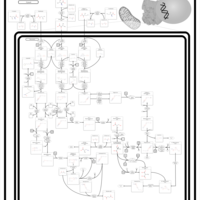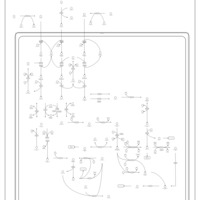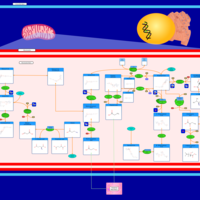| Valine, leucine and isoleucine degradation |    |
| Propanoate metabolism |    |
| Lysine degradation |    |
| Pyruvate metabolism |    |
| beta-Alanine metabolism |    |
| Biosynthesis of unsaturated fatty acids |    |
| Glycine, serine and threonine metabolism |    |
| Tryptophan metabolism |    |
| Steroid Biosynthesis |    |
| Caffeine Metabolism |    |
| Oxidation of Branched Chain Fatty Acids |    |
| Amino Sugar Metabolism |    |
| Fatty acid Metabolism |    |
| Fatty Acid Elongation In Mitochondria |    |
| Citric Acid Cycle |    |
| Ketone Body Metabolism |    |
| Glutamate Metabolism |    |
| Butyrate Metabolism |    |
| Retinol Metabolism |    |
| Ibandronate Action Pathway |    |
| Simvastatin Action Pathway |    |
| Pravastatin Action Pathway |    |
| Rosuvastatin Action Pathway |    |
| Alendronate Action Pathway |    |
| Lovastatin Action Pathway |    |
| Zoledronate Action Pathway |    |
| Cerivastatin Action Pathway |    |
| Risedronate Action Pathway |    |
| Pamidronate Action Pathway |    |
| Fluvastatin Action Pathway |    |
| Atorvastatin Action Pathway |    |
| 2-Hydroxyglutric Aciduria (D And L Form) |    |
| 2-Methyl-3-Hydroxybutryl CoA Dehydrogenase Deficiency |    |
| 3-Hydroxy-3-Methylglutaryl-CoA Lyase Deficiency |    |
| 3-Methylglutaconic Aciduria Type I |    |
| 3-Methylglutaconic Aciduria Type III |    |
| 3-Methylglutaconic Aciduria Type IV |    |
| Beta-Ketothiolase Deficiency |    |
| Dihydropyrimidine Dehydrogenase Deficiency (DHPD) |    |
| Ethylmalonic Encephalopathy |    |
| Glutaric Aciduria Type I |    |
| Glutaric Aciduria Type I |    |
| Leigh Syndrome |    |
| Malonic Aciduria |    |
| Maple Syrup Urine Disease |    |
| Methylmalonic Aciduria |    |
| Methylmalonic Aciduria Due to Cobalamin-Related Disorders |    |
| Hypercholesterolemia |    |
| Pyruvate Dehydrogenase Complex Deficiency |    |
| Sialuria or French Type Sialuria |    |
| Non Ketotic Hyperglycinemia |    |
| Short Chain Acyl CoA Dehydrogenase Deficiency (SCAD Deficiency) |    |
| Propionic Acidemia |    |
| 3-Methylcrotonyl Coa Carboxylase Deficiency Type I |    |
| Isovaleric Aciduria |    |
| Saccharopinuria/Hyperlysinemia II |    |
| Salla Disease/Infantile Sialic Acid Storage Disease |    |
| Dimethylglycine Dehydrogenase Deficiency |    |
| 4-Hydroxybutyric Aciduria/Succinic Semialdehyde Dehydrogenase Deficiency |    |
| Sarcosinemia |    |
| Lysosomal Acid Lipase Deficiency (Wolman Disease) |    |
| Pyruvate Decarboxylase E1 Component Deficiency (PDHE1 Deficiency) |    |
| Vitamin A Deficiency |    |
| Hyperinsulinism-Hyperammonemia Syndrome |    |
| GABA-Transaminase Deficiency |    |
| Methylmalonate Semialdehyde Dehydrogenase Deficiency |    |
| Homocarnosinosis |    |
| Desmosterolosis |    |
| CHILD Syndrome |    |
| Chondrodysplasia Punctata II, X Linked Dominant (CDPX2) |    |
| Smith-Lemli-Opitz Syndrome (SLOS) |    |
| Tay-Sachs Disease |    |
| Disulfiram Action Pathway |    |
| Ethanol Degradation |    |
| Phytanic Acid Peroxisomal Oxidation |    |
| Refsum Disease |    |
| Fatty Acid Biosynthesis |    |
| Transfer of Acetyl Groups into Mitochondria |    |
| Mitochondrial Beta-Oxidation of Short Chain Saturated Fatty Acids |    |
| Mitochondrial Beta-Oxidation of Medium Chain Saturated Fatty Acids |    |
| Mitochondrial Beta-Oxidation of Long Chain Saturated Fatty Acids |    |
| Dimethylglycine Dehydrogenase Deficiency |    |
| Hyperglycinemia, non-ketotic |    |
| Ureidopropionase Deficiency |    |
| Carnosinuria, carnosinemia |    |
| Malonyl-coa decarboxylase deficiency |    |
| Cholesteryl ester storage disease |    |
| Hyper-IgD syndrome |    |
| Mevalonic aciduria |    |
| Wolman disease |    |
| Adrenoleukodystrophy, X-linked |    |
| Carnitine-acylcarnitine translocase deficiency |    |
| 3-hydroxyisobutyric acid dehydrogenase deficiency |    |
| 3-hydroxyisobutyric aciduria |    |
| Isobutyryl-coa dehydrogenase deficiency |    |
| Isovaleric acidemia |    |
| Hyperlysinemia I, Familial |    |
| Hyperlysinemia II or Saccharopinuria |    |
| G(M2)-Gangliosidosis: Variant B, Tay-sachs disease |    |
| Carnitine palmitoyl transferase deficiency (I) |    |
| Long chain acyl-CoA dehydrogenase deficiency (LCAD) |    |
| Very-long-chain acyl coa dehydrogenase deficiency (VLCAD) |    |
| Carnitine palmitoyl transferase deficiency (II) |    |
| Medium chain acyl-coa dehydrogenase deficiency (MCAD) |    |
| Long-chain-3-hydroxyacyl-coa dehydrogenase deficiency (LCHAD) |    |
| Trifunctional protein deficiency |    |
| Congenital lactic acidosis |    |
| Fumarase deficiency |    |
| Mitochondrial complex II deficiency |    |
| 2-ketoglutarate dehydrogenase complex deficiency |    |
| Pyruvate dehydrogenase deficiency (E3) |    |
| Pyruvate dehydrogenase deficiency (E2) |    |
| Primary hyperoxaluria II, PH2 |    |
| Pyruvate kinase deficiency |    |
| Succinic semialdehyde dehydrogenase deficiency |    |
| Short-chain 3-hydroxyacyl-CoA dehydrogenase deficiency (SCHAD) |    |
| Succinyl CoA: 3-ketoacid CoA transferase deficiency |    |
| Pyridoxine dependency with seizures |    |
| Warburg Effect |    |
| 2-aminoadipic 2-oxoadipic aciduria |    |
| 3-Phosphoglycerate dehydrogenase deficiency |    |
| Acylcarnitine 3-Hydroxydecanoylcarnitine |    |
| Acylcarnitine (7Z,9Z,12Z,15Z,18Z,21Z)-tetracosa-7,9,12,15,18,21-hexaenoylcarnitine |    |
| Acylcarnitine Pentacosanoylcarnitine |    |
| Acylcarnitine Hexacosanoylcarnitine |    |
| Acylcarnitine (17Z)-Hexacos-17-enoylcarnitine |    |
| Acylcarnitine (13Z,16Z)-Hexacosa-13,16-dienoylcarnitine |    |
| Acylcarnitine Heptacosanoylcarnitine |    |
| Acylcarnitine Octacosanoylcarnitine |    |
| Acylcarnitine Nonacosanoylcarnitine |    |
| Acylcarnitine (2S,3R)-3-Hydroxy-2-methylbutanoylcarnitine |    |
| The oncogenic action of 2-hydroxyglutarate |    |
| The Oncogenic Action of Succinate |    |
| The Oncogenic Action of Fumarate |    |
| Glutaminolysis and Cancer |    |
| The oncogenic action of L-2-hydroxyglutarate in Hydroxygluaricaciduria |    |
| The oncogenic action of D-2-hydroxyglutarate in Hydroxygluaricaciduria |    |